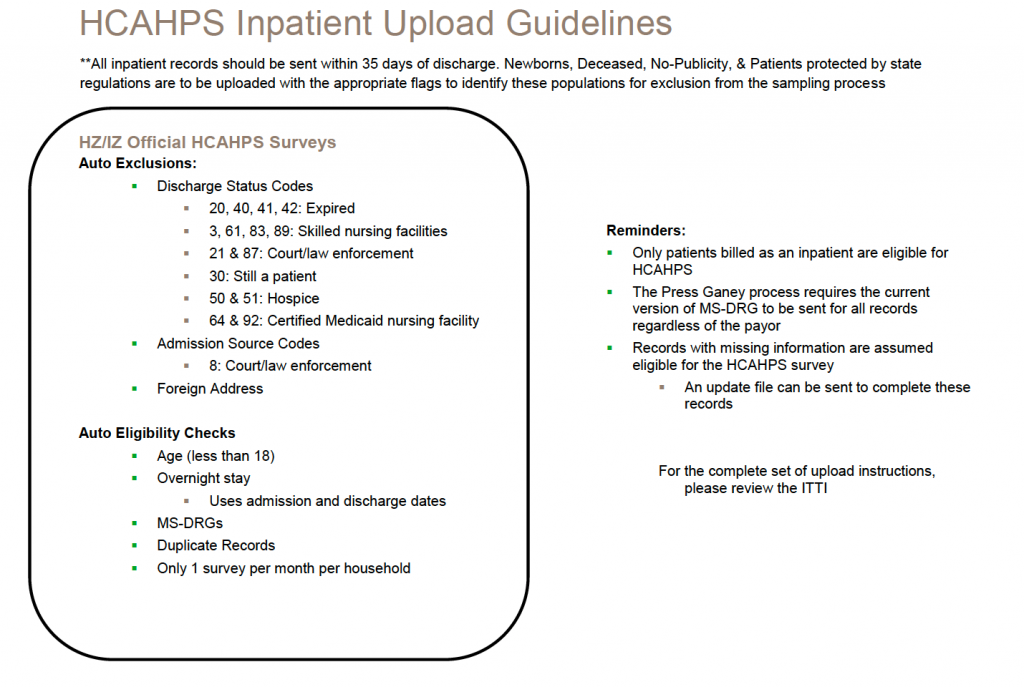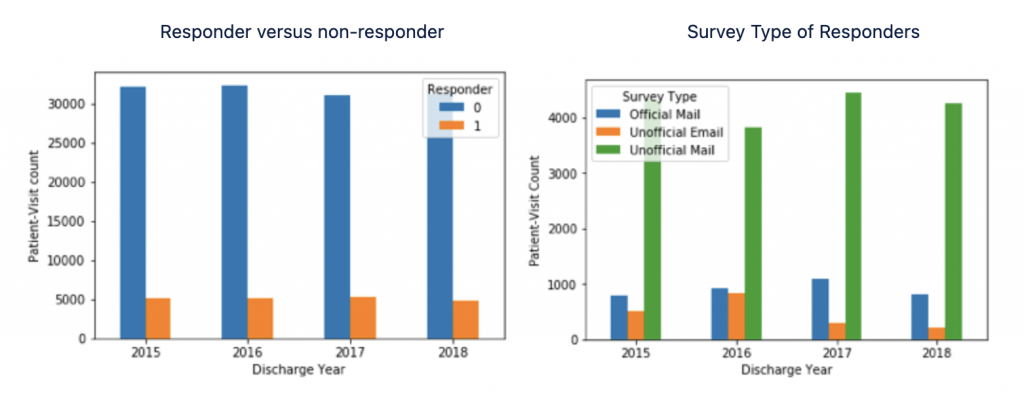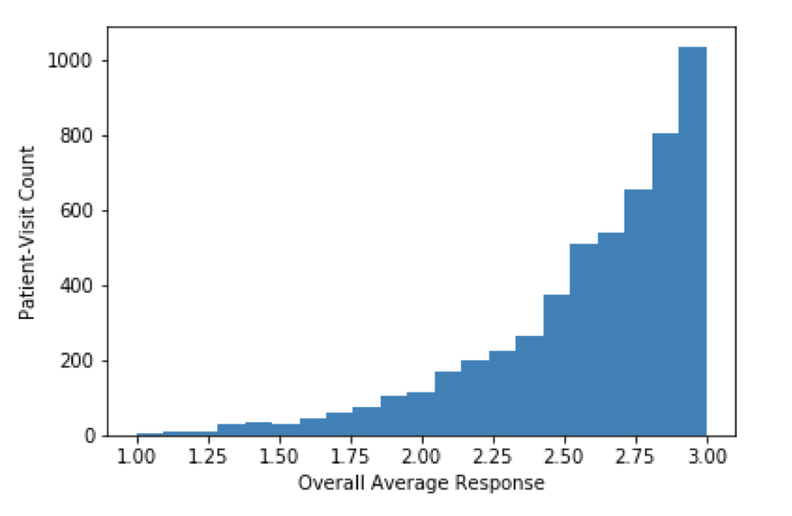The objective of the Patient Experience project is to predict patients who are most likely to report a sub-optimal inpatient experience in order to initiate service recovery, or other engagement strategies of the patient experience team, prior to discharge. The expectation is that this will increase overall patient satisfaction with their Mount Sinai hospital experience, as measured by the HCAHPS patient experience scores. This in turn would positively impact the MSHS reputation and increase reimbursement from Medicare and other value-based payment structures.
The project was deployed at Mount Sinai Hospital in January 2021 and since then has expanded to almost all hospitals in the Mount Sinai system.
Background Information
HCAHPS (Hospital Consumer Assessment of Healthcare Providers and Systems) and Press Ganey
The HCAHPS (“H-caps) survey is a national, standardized, publicly reported survey of patients’ perspectives of their hospital care and experience[1]. Public reporting of the survey results increases the transparency of the quality of hospital care provided, and can impact both hospital reputation and reimbursement. HCAHPS results typically account for 25% of a hospital’s value-based purchasing score – directly impacting the amount of Medicare payments received[2]. Press Ganey is the largest HCAHPS administrator in the country, and distributes the survey for Mount Sinai patients. The Press Ganey patient experience surveys may combine the required HCAHPS questions, often focused on how often certain services were provided, with additional questions on how well the service was provided, in order to better capture the overall patient experience.
Patient Eligibility
All patient discharges that adhere to the official HCAHPs inclusion and exclusion criteria are eligible to be selected for the official HCAHPS survey (see below). Approximately 10% of all eligible patients will be randomly selected by Press Ganey for the official mail survey, 75% for the unofficial mail survey, and the remaining 15% for the unofficial email version of the survey (for those patients with a valid email address).

Data
Press Ganey
All inpatient records, including the current version of MS-DRG billing information, are sent to Press Ganey within 35 days of discharge. Press Ganey distributes the paper or email survey, and receives most responses within 3 months (18% / 85% / 95% within 1 / 2 / 3 months, respectively). Mount Sinai receives daily XML feeds from Press Ganey with the latest survey results. The data dictionary for the Press Ganey survey data is shown below.
| Column Name | Description | ||||||||||
|---|---|---|---|---|---|---|---|---|---|---|---|
| DIS YEAR | All variations and concatenations of the patient discharge date. I use “Discharge Date”, as that is easily linked to Tableau. | ||||||||||
| DIS MONTH | |||||||||||
| Discharge Period | |||||||||||
| Discharge Date DT | |||||||||||
| Discharge Date | |||||||||||
| Receive Date DT | Variations of received date, which is the date Press Ganey received the survey back from the patient. | ||||||||||
| Receive Date | |||||||||||
| FACID | Ignore—Hospital Identifier from the PG side | ||||||||||
| Hospital | Hospital | ||||||||||
| Unit | Unit description | ||||||||||
| Specialty | Case specialty based on MRN+Discharge Date | ||||||||||
| MRN | Patient MRN | ||||||||||
| Encounter No | Encounter Number | ||||||||||
| Sex | F/M | ||||||||||
| Language of Survey | Language of survey | ||||||||||
| Rate overall health | HCAHPS CMS Demo question: In general, how would you rate your overall health? (Poor to Excellent) | ||||||||||
| Highest grade-school completed | HCAHPS CMS Demo question: What is the highest grade or level of school that you have completed? | ||||||||||
| Spanish, Hispanic or Latino | HCAHPS CMS Demo Question: Are you of Spanish, Hispanic, or Latino origin or descent? | ||||||||||
| Race-White | HCAHPS CMS Demo Question: What is your race? Please choose one or more | ||||||||||
| Race-Black or African American | HCAHPS CMS Demo Question: What is your race? Please choose one or more | ||||||||||
| Rate mental – emotional health | HCAHPS CMS Demo question: In general, how would you rate your overall mental or emotional health? (Poor to Excellent) | ||||||||||
| Race-Asian | HCAHPS CMS Demo Question: What is your race? Please choose one or more | ||||||||||
| HCAHPS | Indication for whether patient was selected for OFFICIAL paper sample or unofficial (Unofficial-Mail, Official-Mail) | ||||||||||
| Race-Hawaiian-Pacific Islander | HCAHPS CMS Demo Question: What is your race? Please choose one or more | ||||||||||
| Race-AmeriIndian Alaska Native | HCAHPS CMS Demo Question: What is your race? Please choose one or more | ||||||||||
| Language mainly speak at home | HCAHPS CMS Demo Question: What language do you mainly speak at home? (English, Spanish, Chinese, Russian, Vietnamese, Portuguese, Some other language-please print) | ||||||||||
| Admit through Emergency Room | HCAHPS CMS Demo Question: Were you admitted to this hospital through the Emergency Room? (Yes, No) | ||||||||||
| Pagelink | Unique survey barcode | ||||||||||
| IT Length of Stay | LOS | ||||||||||
| IT SERV_TYP |
|
||||||||||
| IT CMS_AGE | Patient age | ||||||||||
| Question | HCAHPS Question | ||||||||||
| Response | Patient Response recoded on scale of 1-3; full crosswalk below | ||||||||||
| Provider NPI | Discharging Provider NPI | ||||||||||
| Provider Name | Discharging Provider Name | ||||||||||
| Discharged and went home | Where did patient go post-discharge? (Another facility, Another home, Own home) | ||||||||||
| DISTRIB | Method survey distributed (Internet, Paper) | ||||||||||
| ITDOB | Patient date of birth | ||||||||||
| ITCity | Patient city | ||||||||||
| ITZip | Patient zip code | ||||||||||
| Filename | XML File naming convention from PG (includes date sent to us) | ||||||||||
| Load Date | Date the XML was loaded into Oracle |
The responses from each survey question are then converted into a score of 1 (bottom-box), 2 (middle-box) or 3 (top-box).
| Rate this hospital | 9 or 10 (high) | 7 or 8 (medium) | 6 or lower (low) |
| Would Recommend | Definitely yes | Probably Yes | Definitely No and Probably No |
| Responsiveness (Call button help soon as wanted it; Help toileting soon as you wanted) | Always | Usually | Sometimes or Never |
| Pain Management (Pain well controlled; Staff do everything help with pain) OLD_RETIRED | Always | Usually | Sometimes or Never |
| Pain Communication (How often staff talk about pain; Staff talk about pain treatment) NEW 1/1/2018 | Always | Usually | Sometimes or Never |
| Cleanliness | Always | Usually | Sometimes or Never |
| Quietness | Always | Usually | Sometimes or Never |
| Nurse Comm (Nurses treat with courtesy, Nurses listen, Nurses explain) | Always | Usually | Sometimes or Never |
| Doctor Comm (Doctors treat with courtesy, listen, explain) | Always | Usually | Sometimes or Never |
| Comm about Meds (tell you what new meds for, staff describe medicine) | Always | Usually | Sometimes or Never |
| Care transitions (good understanding managing health, hosp staff took pref into account, Understood purpose of taking meds) | Strongly Agree | Agree | Strongly disagree and Disagree |
| Discharge Information (staff talk about help when you left, Info re symptoms/prob to look for) | Yes | —— | No |
| Nurses Check on You Every Hour | Every Hour | Every 2 hours | Every 3 or 4 hours |
| NM Check on You Daily | Yes | —— | No |
Target definition
There are two distinct parts to the objective of predicting patients who are most likely to report a sub-optimal inpatient experience. The first is predicting wether a patient with respond to the survey or not, and the second is to predict those patients who will have a sub-optimal experience. Both will be explored separately, and depending on performance and implementation design, the final solution may include either model or a combination of both.
Responder versus non-responder
The objective is to predict which patients are most likely to respond to a survey. About 5000 (14%) patients respond to the survey every year out of the approximately 35,000 eligible patients who are sent a survey. This represents a combination of official mail, unofficial mail, and unofficial email surveys, typically 10% / 75% / 15% respectively. Note: currently we do not have the data on which patients were actually sent surveys; non-responders are defined as patients who meet the eligibility criteria to be sent a survey, but for which no survey response data was matched. As such, we do not know which patient was sent which type of survey, so we cannot access wether the relative decrease of unofficial email responders in 2017 and 2018 was due to fewer surveys distributed via that channel or an actual drop in response rate.

Sub-optimal patient experience
The objective is to predict which patients are most likely to have a sub-optimal patient experience. Of the approximately 5000 patients responding to the survey annually, about a 30% of those patients will have a sub-optimal patient experience (< 2.5 average response across all HCAHPS questions). Note: we may combine the sub-scores by an alternative method pending further discussion with the Patient Experience team.

References
- HCAHPS: Patients’ Perspective of Care Survey, CMS.gov, https://www.cms.gov/Medicare/Quality-Initiatives-Patient-Assessment-instruments/hospitalqualityinits/hospitalHCAHPS.html
- HCAHPS Regulatory Survey: Press Ganey, http://www.pressganey.com/solutions/service-a-to-z/hcahps-regulatory-survey
- Mazurenko, O., Collum, T., Ferdinand, A., Menachemi, N. (2017). Predictors of Hospital Patient Satisfaction as Measured by HCAHPS: A Systematic Review. Journal of Healthcare Management., 62(4), 272-283. https://doi.org/10.1097/JHM-D-15-00050
- Batbaatar, E., Dorjdagva, J., Luvsannyam, A., Savino, MM., Amenta, P. (2017). Determinants of patient satisfaction: a systematic review. Perspectives in Public Health. 137(2), 89-101. https://doi.org/10.1177/1757913916634136
- Cleghorn, MC., Elnahas, A., Tse, A., Maeda, A., Quereshy, FA., Okrainec, A., Jackson, TD. (2018). Is quality important to our patients? The relationship between surgical outcomes and patient satisfaction. BMJ Quality and Safety. 27(1), 48-52. https://doi.org/10.1136/bmjqs-2017-007071
- Palese, A., Gonella, S., Fontanive, A., Guarnier, A., Barelli, P., Zambiasi, P., Allegrini, E., Bazoli, L., Casson, P., Marin, M., Padovan, M., Picogna, M., Taddia, P., Salmaso, D., Chiari, P., Frison, T., Marognolli, O., Canzan, F., Ambrosi, E., Saiani, L. (2017). The degree of satisfaction of in-hospital medical patients with nursing care and predictors of dissatisfaction: findings from a secondary analysis. Scandinavian Journal of Caring Sciences. 31(4), 768-778. https://doi.org/10.1111/scs.12396
- Shirley, ED., Sanders, JO. (2013). Patient satisfaction: Implications and predictors of success. Journal of Bone and Joint Surgery, American Volume. 95(10), e69. https://doi.org/10.2106/JBJS.L.01048
- MacAllister L., Zimring C., Ryherd E. (2016). Environmental Variables That Influence Patient Satisfaction: A Review of the Literature. Health Environments Research and Design Journal. 10(1), 155-69. https://doi.org/10.1177/1937586716660825
- Fallon E., Fung S., Rubal-Peace G., Patanwala AE. (2016). Predictors of Patient Satisfaction With Pain Management in the Emergency Department. Advanced Emergency Nursing Journal 38(2), 115-22. https://doi.org/10.1097/TME.0000000000000096
- McFarland DC., Shen MJ., Holcombe RF. (2016). Predictors of patient satisfaction with inpatient hospital pain management across the United States: A national study. Journal of Hospital Medicine. 11(7), 498-501. https://doi.org/10.1002/jhm.2576
- Goldwag R., Berg A., Yuval D., Benbassat J. (2002). Predictors of patient dissatisfaction with emergency care. The Israel Medical Association Journal. 4(8), 603-6. https://www.ncbi.nlm.nih.gov/pubmed/12183864

